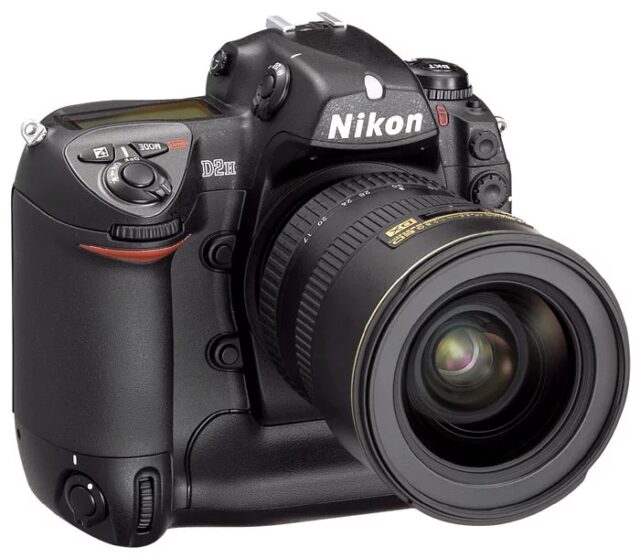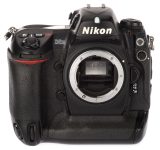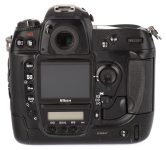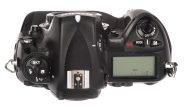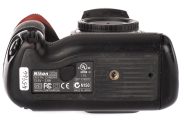Announced
Production status
System
Nikon F APS-C system cameras
- Nikon D1
- Nikon D100
- Nikon D1H
- Nikon D1X
- Nikon D200
- Nikon D2H
- Nikon D2Hs
- Nikon D2X
- Nikon D2Xs
- Nikon D300
- Nikon D3000
- Nikon D300s
- Nikon D3100
- Nikon D3200
- Nikon D3300
- Nikon D3400
- Nikon D3500
- Nikon D40
- Nikon D40X
- Nikon D50
- Nikon D500
- Nikon D5000
- Nikon D5100
- Nikon D5200
- Nikon D5300
- Nikon D5500
- Nikon D5600
- Nikon D60
- Nikon D70
- Nikon D7000
- Nikon D70s
- Nikon D7100
- Nikon D7200
- Nikon D7500
- Nikon D80
- Nikon D90
Nikon D2H
APS-C AF digital SLR camera • Discontinued
Specification
| Format: | |
| APS-C | |
Imaging sensor: | 23.3 × 15.5mm JFET sensor |
Resolution: | 2464 × 1632 - 4 MP |
Crop factor: | 1.55x |
Sensor-shift image stabilization: | - |
| Nikon F [46.5mm] | |
| Shutter: | |
Type: | Focal-plane |
Model: | Electronically controlled |
Speeds: | 30 - 1/8000 + B |
| Exposure: | |
Exposure metering: | Through-the-lens (TTL), open-aperture |
Exposure modes: | Programmed Auto |
| Aperture-priority Auto | |
| Shutter-priority Auto | |
| Manual | |
| Physical characteristics: | |
Weight: | 1070g |
Dimensions: | 157.5x149.5x85.5mm |
Manufacturer description
July 22, 2003. 08:00 CET. Amsterdam, The Netherlands. Introducing the Nikon D2H, a Professional digital SLR camera that premieres a host of groundbreaking digital technology and photographic features for high speed image capture with instant photographic response, speed and accuracy. The D2H is a totally new design, and incorporates the following feature highlights;
Digital:
- 8 fps burst with continuous shooting up to 40 shots (JPEG)
- Exclusive Nikon DX Format 4.1 million effective pixel imaging sensor
- Innovative JFET LBCAST Sensor architecture
- New WB metering system with Ambient WB Sensor
- Optional WT-1 Wireless Transmitter compatible to IEEE802.11b
- USB 2.0 wired interface
- 3 colour mode options (2 sRGB options, AdobeRGB wide gamut)
- Extra large 2.5 inch 211,000 pixel LCD Monitor
- New viewfinder display of file format and WB settings
- Flash Colour Information Communication with new Speedlight SB-800
- Combined RAW+JPEG file saving
Photographic:
- New 11-area Dynamic Auto focus System
- 37ms shutter lag, 80ms viewfinder blackout
- Tough new mechanical shutter and mirror balancer system
- 100% viewfinder frame coverage
- New AF area illumination system maintains compact prism profile
- New Intelligent Lithium battery system
- Completely new magnesium body design with refined ergonomics
- Highly resistant environmental protection
New Nikon DX Format JFET Imaging Sensor LBCAST
Nikon’s exclusive new LBCAST JFET imaging sensor features higher speed, higher resolution, lower power consumption and minimal dark noise. Its innovative design eliminates the need to perform fixed pattern noise correction to deliver instant shutter release availability and minimal shutter lag, to deliver the instant response professionals demand. A new thinner OLPF effectively suppresses moiré patterns. The DX sensor format is consistent with all other Nikon D series SLR’s to offer consistent lens picture angles whichever Nikon body(s) are being used.
New High-speed, High-precision 11-Area AF System with 9 Cross-Type AF Sensors
The new advanced Multi-CAM2000 AF sensor module ensures quick response and razor sharp focus regardless of shooting conditions. Featuring 11 sensors to cover the majority of the image area with 9 sensitive Cross type sensors spread in a convenient rule of thirds layout. The result is precise AF performance based upon compositional demands rather than concentrated toward the centre of the frame.
New Auto White Balance and Auto Tone Control System
New metering technology combines three separate methods to achieve refined Auto White Balance (AWB) and Auto Tone Control (ATC) especially under changing lighting conditions.
These sensors are:
- Nikon’s acclaimed 1005-pixel RGB Exposure/Colour Matrix Metering Sensor that performs direct TTL metering of the subject.
- LBCAST imaging sensor calculates the lighting characteristics of the actual image data
- Additional external Ambience Light Sensor meters ambient light without being influenced by the subject colour, whilst also recognizing light flicker to distinguish artificial from natural light.
Revised integrated signal processing and AWB and ATC algorithms contribute to deliver refined colour and tone reproduction automatically. Manual control is also refined with new Pre-set input options or using by Kelvin colour temperature scale.
Image Transmission Direct from Camera
A unique, optional Wireless Transmitter WT-1 enables direct FTP image transmission from camera in a managed Wireless LAN network infrastructure. Attached to the base of the camera, the new pack is IEEE 802.11b compatible and facilitates image transfer without interrupting full camera functionality. The photographer can continue to shoot and capture images as normal even during transmission.
Viewfinder
The D2H features a 100% coverage, high eye-point viewfinder with a ‘blackout’ time of just 80ms. Additional vertical information panel displays File format, WB and ISO settings. A totally redesigned AF Area LED illumination system maintains a compact prism profile.
Shutter and Mirror Balancer
The D2H incorporates a tough mechanical shutter mechanism refined from that used in the Nikon F5 Professional film camera. With dual blades manufactured from duralumin, a composite material used in the aircraft industry, renowned for it’s tensile strength.
The D2H shutter is, like the F5, tested to over 150, 000 cycles*.
A class leading shutter lag of just 37ms** delivers the instant response demanded by action photographers. Attention too, has been given to the mirror balancer mechanism contributing to a class leading viewfinder blackout time of just 80ms** during consecutive shooting.
Improved ergonomics and durability
In lessons learnt from extensive Professional feedback the camera boasts Command and Sub Command dials for both horizontal and vertical shooting, larger AF-On buttons and a new 8 direction multi-selector pad with centre push function button, bringing major improvements to the ergonomics of using Auto focus during shooting as well as instant image playback while writing to the CF card.
The slim body design incorporates a generous 2.5in TFT screen in a silhouette just 3mm thicker than the F5 film SLR.
The complex digital and photographic technology is contained in a body of magnesium for strength and rigidity, but that is lighter than both the Nikon D1H it replaces, and the Nikon F5, without compromising durability or environmental resistance.
New Intelligent Lithium Power Supply System
The Intelligent Lithium battery chemistry combines high energy capacity, extended life in a light weight package. The new EN-EL4 intelligent lithium battery is almost 50% more powerful than the EN-4 Ni-MH battery of the D1 series, but 25% lighter. Free of memory effect, it can be recharged at any time. An accurate indicator on the camera’s LCD monitor displays the percent of remaining charge, the status of battery life and recommends calibration when necessary.
New Creative Lighting System
Nikon’s new Speedlight SB-800 with i-TTL flash control further evolves D-TTL to introduce features that include Flash Value Lock (FV-Lock), Auto FP High Speed Sync (up to 1/8000th second shutter speed), and Flash Colour Information Communication. The SB-800 incorporates a Wide Area AF illumination system tailored to the D2H 11-area AF system.
Additional Features
- Camera orientation sensor
- One button Zoom playback during image write
- Kelvin colour temperature Pre-Sets in 31 levels from 2500K to 10000K
- New WB Pre-set option includes apply-from-shot image option
- Built in voice memo recorder with Auto record option
- Alpha numeric text input stored in EXIF header
- Built-in intervalometer for time lapse exposures
- Basic Matrix metering for Nikkor lenses without a CPU
- New B type Brite View Clear Matte Screen III
- Colour coded Menus
- USB 2.0/DC-IN/ Video Out ports on body side.
- 10 pin remote terminal
- IS0 519 X sync terminal
- Package includes intelligent lithium battery EN-EL4 and calibration charger MH-21.
Nikon Software Solutions
Versatile functions of the bundled Nikon View software simplify data transfer and offers faster browsing, with a new Auto rotation of images shot in portrait orientation.
New Nikon Capture 4 adds practical levels of post capture control over NEF (Raw) files:
- New Image Dust Off: sensor dust and particle shade removal control
- Digital DEE: scene specific automatic dodge and burn control
- Fisheye distortion correction: Transforms fisheye shots into rectangular ultra-wide images.
Capture 4 also includes Vignette Control, improved batch processing and full camera control functions for tethered Remote Camera control.
Speaking about the D2H, Robert Cristina, Marketing Executive Professional Film and Digital, Nikon Europe, said: “The D2H is a major step forward for high speed digital photography. Over two years in development, the camera is the result of extensive research amongst Professionals working in a variety of fields, especially news and sport.”
Similar cameras (4)
APS-C • Auto focus • Digital • Singe-lens reflex • Nikon F mount
| Model | Shutter | Metering | Modes | Year |
|---|---|---|---|---|
| Fujifilm FinePix S1 Pro | E, 1/2000 | TTL • OA | PASM | 2000 ● |
| Fujifilm FinePix S2 Pro | E, 1/4000 | TTL • OA | PASM | 2002 ● |
| Fujifilm FinePix S3 Pro | E, 1/4000 | TTL • OA | PASM | 2004 ● |
| Fujifilm FinePix S5 Pro | E, 1/8000 | TTL • OA | PASM | 2006 ● |
